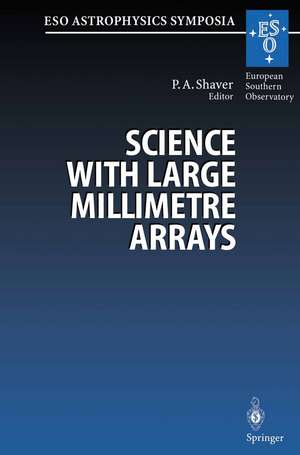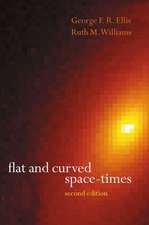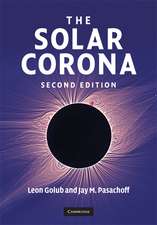Science with Large Millimetre Arrays: Proceedings of the ESO-IRAM-NFRA-Onsala Workshop, Held at Garching, Germany 11–13 December 1995: ESO Astrophysics Symposia
Editat de Peter Shaveren Limba Engleză Paperback – 18 apr 2014
Din seria ESO Astrophysics Symposia
- 15%
 Preț: 656.43 lei
Preț: 656.43 lei - 15%
 Preț: 656.10 lei
Preț: 656.10 lei -
 Preț: 369.78 lei
Preț: 369.78 lei -
 Preț: 404.51 lei
Preț: 404.51 lei - 15%
 Preț: 644.95 lei
Preț: 644.95 lei - 15%
 Preț: 656.43 lei
Preț: 656.43 lei -
 Preț: 391.97 lei
Preț: 391.97 lei - 18%
 Preț: 971.01 lei
Preț: 971.01 lei -
 Preț: 434.94 lei
Preț: 434.94 lei - 15%
 Preț: 650.86 lei
Preț: 650.86 lei -
 Preț: 402.98 lei
Preț: 402.98 lei -
 Preț: 403.90 lei
Preț: 403.90 lei -
 Preț: 412.78 lei
Preț: 412.78 lei - 15%
 Preț: 645.47 lei
Preț: 645.47 lei -
 Preț: 431.30 lei
Preț: 431.30 lei - 15%
 Preț: 649.06 lei
Preț: 649.06 lei -
 Preț: 402.56 lei
Preț: 402.56 lei - 15%
 Preț: 647.27 lei
Preț: 647.27 lei -
 Preț: 413.15 lei
Preț: 413.15 lei -
 Preț: 409.30 lei
Preț: 409.30 lei -
 Preț: 430.10 lei
Preț: 430.10 lei -
 Preț: 406.42 lei
Preț: 406.42 lei - 15%
 Preț: 658.05 lei
Preț: 658.05 lei - 20%
 Preț: 590.38 lei
Preț: 590.38 lei -
 Preț: 400.65 lei
Preț: 400.65 lei -
 Preț: 413.15 lei
Preț: 413.15 lei - 15%
 Preț: 658.70 lei
Preț: 658.70 lei -
 Preț: 401.79 lei
Preț: 401.79 lei -
 Preț: 436.70 lei
Preț: 436.70 lei -
 Preț: 404.13 lei
Preț: 404.13 lei
Preț: 396.02 lei
Nou
Puncte Express: 594
Preț estimativ în valută:
75.79€ • 78.83$ • 62.57£
75.79€ • 78.83$ • 62.57£
Carte tipărită la comandă
Livrare economică 15-29 aprilie
Preluare comenzi: 021 569.72.76
Specificații
ISBN-13: 9783662223956
ISBN-10: 3662223953
Pagini: 432
Ilustrații: XVII, 409 p. 206 illus.
Dimensiuni: 155 x 235 x 23 mm
Greutate: 0.6 kg
Ediția:Softcover reprint of the original 1st ed. 1996
Editura: Springer Berlin, Heidelberg
Colecția Springer
Seria ESO Astrophysics Symposia
Locul publicării:Berlin, Heidelberg, Germany
ISBN-10: 3662223953
Pagini: 432
Ilustrații: XVII, 409 p. 206 illus.
Dimensiuni: 155 x 235 x 23 mm
Greutate: 0.6 kg
Ediția:Softcover reprint of the original 1st ed. 1996
Editura: Springer Berlin, Heidelberg
Colecția Springer
Seria ESO Astrophysics Symposia
Locul publicării:Berlin, Heidelberg, Germany
Public țintă
ResearchCuprins
1. Introduction.- Millimetre Astronomy in the 21st Century.- A 10000m2 Southern MM Array.- 2. Science with Large Millimetre Arrays.- The Nature and Observability of Protogalaxies.- Observability of Early Evolutionary Phases of Galaxies at mm Wavelengths.- Studying High Redshift Starburst Galaxies with a Large (Sub)millimetre Array.- Deep Surveys with a Large Submillimetre Array.- The LSA and Galaxy Surveys.- The LSA and Gravitational Lensing.- Primordial Molecules.- 1.3 mm Detection and Mapping of Radioquiet QSOs at Very High z.- Molecular Lines in Absorption (and Emission) from Distant Galaxies and Quasars.- Millimeter-VLBI with a Large Millimeter Array: Future Possibilities.- The Variable Microwave Continuum of Radio-Loud AGN.- Millimeter Radiation from Normal Galaxies and AGN.- Submillimetre Observations of Low Ionization BAL Quasars.- Dynamical Studies of Spiral Galaxies.- Kinematics and Distribution of Molecular Gas in Galaxy Nuclei.- Star Formation and Molecular-Gas Dynamics in Galaxies with the Nobeyama Array and LSA.- Radio Recombination Lines from External Galaxies.- Molecular Gas in Early-Type Galaxies.- Magellanic Cloud Studies with Large mm Arrays.- Will the LSA Detect Continuum or Line Emission from AGB Stars in the LMC?.- High-Resolution Submm and MIR Imaging of the Central Parsec of the Milky Way.- New Evidence for Interaction of a Molecular Cloud/HII Region with the G359.54+0.18 Nonthermal Filaments.- Galactic Molecular Clouds.- Millimeter-Wave Absorption Spectroscopy of Molecular Clouds.- Astrochemistry.- Abundance and Origin of Galactic Water.- Interferometric Observations of Sagittarius B2: Evidence for Grain Chemistry.- A Hot Ring in the Sgr B2 Molecular Cloud.- High-Density Filaments in the Photodissociation Region (PDR) Associated with NGC 7023.- Searching for Star Formation Regions.- Infrared and mm Data for Class I Candidates.- Observations of Young Stellar Objects with Large Millimeter-Wave Arrays.- Protoplanetary Disks.- Observations of Bipolar Molecular Outflows with Large Millimeter Arrays.- Accretion and Outflow in a Protostellar System in Corona Australis.- Masers at Millimeter and Submillimeter Wavelengths.- Millimeter Recombination Lines from Dense Envelopes Around Young Stars.- Millimeter Continuum Observations of Stars.- AGB Star Envelopes as Probes of Stellar Evolution and Time-Dependent Chemistry.- CO Observations of Short Period Miras.- Planetary Nebulae.- Supernovae with the Large Southern Array.- Study of Planetary Atmospheres.- Asteriods and Comets: The Prospect for Observations with a Large Millimetre Array.- An Extension of the European Millimetre VLBI Network: Plans for a mm Radiotelescope in Greece.- Science with Large Millimetre Telescopes.- 3. A Large Millimetre Array in the Southern Hemisphere.- The Synergy Between a Large Southern Array and the Very Large Telescope of ESO.- A European Study Project for a Southern Millimetre Array.- Large Southern Array: Feasibility.- On the Imaging Efficiency, Speed, and Sensitivity of Millimetre Arrays.- Site Survey for a Large Southern Array.- Correction of Atmospheric Phase Fluctuations.- Atmospheric Phase Correction Based on Sky Emission in the 210–248 GHz Band.- Phase Correction Strategies for the Australia Telescope Compact Array at Short Wavelengths.- Innovative Telescope Designs.- Millimetre Receiver Technology for a Large Array.- Correlator Developments for (Sub)millimeter Telescopes.- 4. Workshop Summary.- Concluding Remarks.
Textul de pe ultima copertă
The next major step in millimetre astronomy, and one of the highest-priority items in radio astronomy today, is a very large millimetre array. It will be the millimetre counterpart of the Hubble Space telescope and the new optical telescopes currently under construction, such as ESOs Very Large Telescope. As such it will produce a wide range of important scientific results in all areas of modern astrophysics, particularly cosmology and the origins of galaxies, stars, and planets. This book summarizes the exciting science that will become possible, ranging from the most distant and earliest galaxies to the chemistry and physics of star and planet formation. There are also a number of papers on the European concept and project for a large millimetre array in the southern hemisphere.














